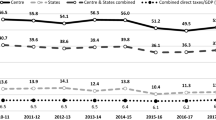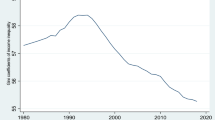Abstract
The level of income inequality in a country is usually a contentious and politically divisive issue. How the tax structure affects this inequality is of crucial concern to policymakers. In this paper, we examine the income tax experiences of five European Union countries: Belgium, Bulgaria, Germany, Lithuania, and Poland. This paper focuses on the comparison between flat and graduated personal income tax rate structures. Various methods were used to measure the progressivity of income taxes across these countries such as the average tax rate, cumulative shares of income, and the Gini and other indices. The findings show that the graduated rate income tax structure of Germany and Belgium are the most effective at reducing inequality. On the other hand, Lithuania’s proportional income tax structure is much more effective at reducing income inequality when compared to the graduated rate structure of Poland. Also, an appropriately-sized income tax threshold can transform a flat structure to a redistributive one that compares favorably with some graduated rate structures. In the case of Bulgaria, introducing an income tax threshold that is roughly the size of average income would reduce inequality by about 4 %.

Similar content being viewed by others
Notes
These progressivity measures, referred to in the literature as effective progression, were different from structural progression which is measured using average and marginal tax rates.
This concept of cumulative shares was what was used to derive the Lorenz curve.
References
Adhikari, B., & Alm, J. (2016). Evaluating the economic effects of flat tax reforms using synthetic control methods. Southern Economic Journal, 83(2), 437–463.
Alm, J., Lee, F., & Wallace, S. (2005). How fair? Changes in federal income taxation and the distribution of income, 1978 to 1998. Journal of Policy Analysis and Management, 24(1), 5–22.
Alstadsæter, A., Johannesen, N., & Zucman, G. (2017). Tax evasion and inequality (Working Paper No. 23772). National Bureau of Economic Research. https://doi.org/10.3386/w23772
Andreoni, J., Erard, B., & Feinstein, J. (1998). Tax compliance. Journal of Economic Literature, 36(2), 818–860.
Binelli, C., & Attanasio, O. (2010). Mexico in the 1990s: the Main cross-sectional facts. Review of Economic Dynamics, 13(1), 238–264.
Cebula, R. J., & Feige, E. L. (2012). America’s unreported economy: measuring the size, growth and determinants of income tax evasion in the U.S. Crime, Law and Social Change, 57(3), 265–285.
De Agostini, P., Myck, M., & Paukszteło, W. (2017). Poland 2014–2017. EUROMOD Country Report, University of Essex.
De Maio, F. G. (2007). Income inequality measures. Journal of Epidemiology and Community Health, 61(10), 849–852.
Dolls, M., Fuest, C., & Peichl, A. (2012). Automatic stabilizers and economic crisis: US vs. Europe. Journal of Public Economics, 96, 279–294.
Duncan, D., & Sabirianova Peter, K. (2016). Unequal inequalities: do progressive taxes reduce income inequality? International Tax and Public Finance, 23(4), 762–783.
EUROMOD. (2017). EUROMOD Hypothetical Household Tool (HHoT). User manual (EUROMOD Technical Note No. EMTN 4.0).
EUROMOD (2018). HHoT manual and households. Retrieved May 31, 2018, from https://www.euromod.ac.uk/using-euromod/user-resources/hhot-manual-households.
Fuchs-Schündeln, N., Krueger, D., & Sommer, M. (2010). Inequality trends for Germany in the last two decades: a tale of two countries. Review of Economic Dynamics, 13(1), 103–132.
Heathcote, J., Perri, F., & Violante, G. L. (2010). Unequal we stand: an empirical analysis of economic inequality in the United States, 1967–2006. Review of Economic Dynamics, 13(1), 15–51.
Hufkens, T., Maes, S., Cant, L. V., Vanhille, J., & Vanheukelom, T. (2017). Belgium 2014–2017. EUROMOD Country Report, University of Essex.
Idrees, M., & Ahmad, E. (2017). Measurement of income inequality: a survey. Forman Journal of Economic Studies, 13, 1–32.
International Labour Organisation, Commonwealth of Independent States, Organisation for Economic Co-operation and Development, & International Monetary Fund. (2002). Measuring the Non-observed Economy : A Handbook. Paris, France: International Monetary Fund.
Kakwani, N. C. (1977). Measurement of tax progressivity: an international comparison. The Economic Journal, 87(345), 71–80.
Kula, M. C., & Millimet, D. L. (2010). Income inequality, taxation, and growth. Atlantic Economic Journal, 38(4), 417–428. https://doi.org/10.1007/s11293-010-9244-0.
Ledbetter, M. (2007). Comparison of BEA estimates of personal income and IRS estimates of adjusted gross income. Survey of Current Business. Retrieved from https://www.highbeam.com/doc/1G1-172524922.html.
Loudermilk, B. (2017). The world’s highest taxed countries. Retrieved November 1, 2018, from https://www.worldatlas.com/articles/countries-with-the-highest-taxes-in-the-world.html.
Musgrave, R. A., & Thin, T. (1948). Income tax progression, 1929-48. Journal of Political Economy, 56(6), 498–514.
Navickė, J., & Čižauskaitė, A. (2017). Lithuania 2014–2017. EUROMOD Country Report, University of Essex.
Organization for Economic Co-operation and Development. (2002). Measuring the non-observed economy : A handbook. Paris: OECD Publications Service https://www.oecd.org/sdd/na/1963116.pdf.
Peichl, A. (2009). The benefits and problems of linking micro and macro models – Evidence from a flat tax analysis. Journal of Applied Economics, 12, 301–329.
Petroff, A. (2016). Belgium has the highest income taxes in the developed world. Retrieved November 1, 2018, from https://money.cnn.com/2016/04/12/pf/taxes/income-tax-belgium-oecd/index.html.
Poterba, J., & Sinai, T. (2008). Tax expenditures for owner-occupied housing: deductions for property taxes and mortgage interest and the exclusion of imputed rental income. American Economic Review, 98(2), 84–89.
Schuetze, C. F. (2017). Talk of economic inequality surfaces in the German election | Best Countries | US News. Retrieved November 2, 2018, from https://www.usnews.com/news/best-countries/articles/2017-09-22/talk-of-economic-inequality-surfaces-in-the-german-election.
Stiglitz, J. E. (2012). The price of inequality: How today’s divided society endangers our future. Page lvi: WW Norton & Company.
Trading Economics. (2018). Retrieved May 30, 2018, from https://tradingeconomics.com/indicators.
Vasilev, A. (2015). Welfare effect of flat income tax reform: the case of Bulgaria. Eastern European Economics, 53(3), 205–220.
Weller, C. E., & Rao, M. (2010). Progressive tax policy and economic stability. Journal of Economic Issues, 44(3), 629–659.
Williams, C., Bejaković, P., Mikulić, D., Franic, J., Kedir, A., & Horodnic, I. A. (2017). An evaluation of the scale of undeclared work in the European Union and its structural determinants: estimates using the labour input method (SSRN Scholarly Paper No. ID 3092080). Rochester: Social Science Research Network Retrieved from https://papers.ssrn.com/abstract=3092080.
Acknowledgments
The author wishes to thank participants at the 82nd International Atlantic Economic Conference for comments and suggestions. The paper benefited from the comments of the anonymous referees. All errors are my own.
Author information
Authors and Affiliations
Corresponding author
Additional information
Publisher’s Note
Springer Nature remains neutral with regard to jurisdictional claims in published maps and institutional affiliations.
Rights and permissions
About this article
Cite this article
Stephenson, A.V. The Impact of Personal Income Tax Structure on Income Inequality for Belgium, Bulgaria, Germany, Lithuania, and Poland: A Comparison of Flat and Graduated Income Tax Structures. Atl Econ J 46, 405–417 (2018). https://doi.org/10.1007/s11293-018-9601-y
Published:
Issue Date:
DOI: https://doi.org/10.1007/s11293-018-9601-y




